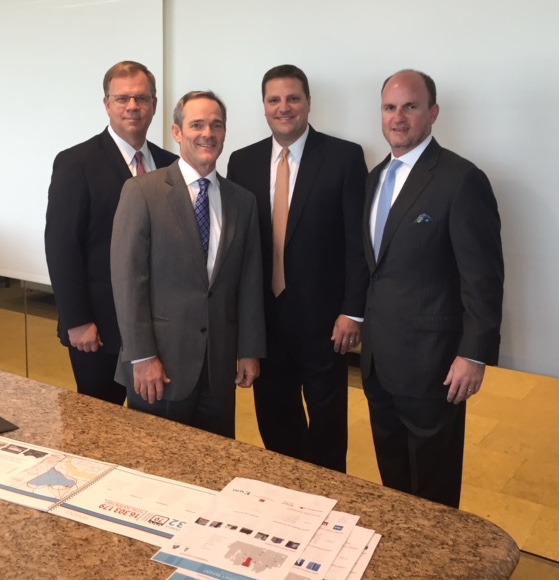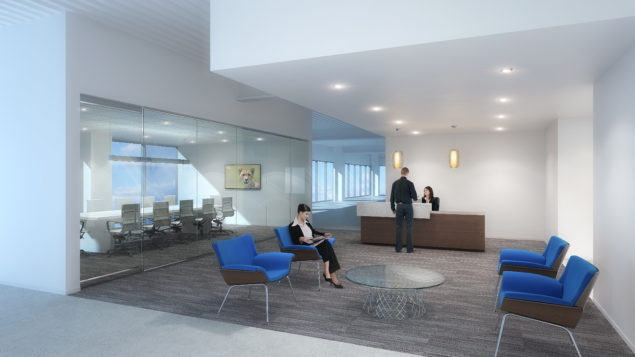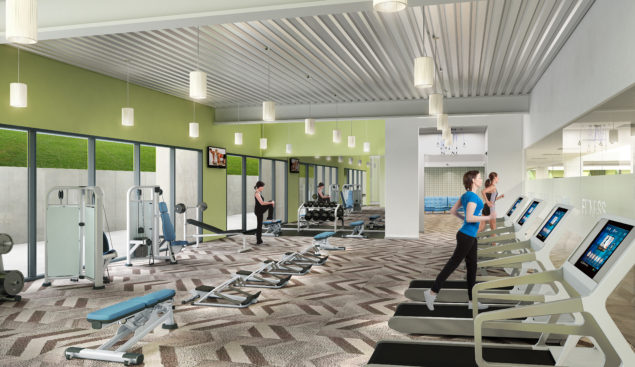
It has been a year since Chuck Sellers, Dale Ray, and Grant Sumner joined Avison Young to launch and lead the firm’s landlord services group in Dallas. Their portfolio now tops 3.5 million square feet. D Real Estate Daily recently sat down with the team to get their take on market activity, where the hot spots are, and what lies ahead.
D REAL ESTATE DAILY: One of your more recent wins is the Fossil headquarters in Richardson, 2323 North Central, which is being revamped.
CHUCK SELLERS: That’s right. KDC hired us to lease the property. They’re going to fill in the atrium on a couple of floors, which will take it to about 140,000 square feet. They’re spending about $5 million, including replacement of the infrastructure. It will essentially be a brand-new building, right on North Central Expressway. Richardson is a very robust, hot market, especially companies looking for large blocks of space, with good parking. KDC has a lot of land with this asset (18 acres), so they can develop an additional 500,000 square feet. Or, if someone needs 10-per-1,000 parking today, that can be accommodated. There’s a lot of flexibility.
GRANT SUMNER: It’s a great opportunity, and on top of that, it’s KDC.
SELLERS: That’s the most important thing about the assignment—the relationship with KDC. They represent class and quality, and they’re great guys—the type of company you want to work with and the type of landlord tenants want to have. They get our business. They understand what it takes to lease buildings.
DRED: Is the building vacant?
SELLERS: Yes. It has been empty since Fossil left. When KDC did a build-to-suit for Blue Cross and Blue Shield a while back, it took over a long-term lease at BCBS’s former location. That property was renovated and became Fossil’s new headquarters. When that happened KDC acquired Fossil’s two buildings, 2323 North Central and 2280 North Greenville Ave. That building was sold to CNL Commercial, and that’s where we did the GEICO lease. KDC decided to hang on to 2323 North Central, put money in it, and lease it. It’s a great asset.
DRED: What kind of activity are you seeing in Richardson?
SELLERS: Overall, the Richardson market is as active and busy as has been in the late 1990s. Look at the transactions that have been done—State Farm and Raytheon at CityLine, GEICO, RealPage, Frontier (even though that’s temporary space). There are a few blocks of space out there that remain, but the ones that have exposure and parking are going to win.
DALE RAY: There are a lot of prospects now, in the 80,000- to 100,000-square-foot range.
DRED: What other markets are popping?
RAY: You always have Las Colinas, and the Urban Center, with The Music Center and Water Street now becoming a reality. To have that destination point/services element is going to be a big boost for the Urban Center. There’s an air of excitement with that now taking place.
SELLERS: The Urban Center has been anything but urban—until now. There’s finally a walkable amenity base. It’s just a given now for employers looking to hire and retain employees—they want the best young talent. Office space is playing a much bigger part in what makes them successful. In the past, tenants would mostly be concerned about the bottom line. That’s no longer the case. It’s about environment. If you’re a landlord, just to be at par, you have to have a renovated or new building, with amenities in the building, and hopefully many others within walking distance.
GRANT SUMNER: In the last five or 10 major deals we’ve done, the HR directors had a huge say, from the short list all the way through. Now they’re on the tours from day one, making sure that the deal and what’s delivered is going to be conducive to what employees are looking for.
RAY: Talking about Las Colinas, that western airport area, Freeport, is a great location. The value of land in that direction is very favorable for a build-to-suit. Land out there is 15 percent to 20 percent less than what it’s going for on the upper tollway.
SUMNER: And the proximity to Dallas-Fort Worth International. Corporations looking at North Texas, and the bottom line, the cost of living, and the traffic isn’t as bad. To that point, the lower part of the [Dallas North Tollway] is seeing a boomerang effect, that area along LBJ Freeway. That market is going to see a lot of activity, as an option to some of the higher-priced options like Preston Center, and you can just fly down LBJ now [with recently highway improvements complete]. It’s the new center of the city.
SELLERS: So in terms of opportunity, obviously Las Colinas—and because of pricing in Preston Center, Uptown, and Far North Dallas—LBJ, North Central Expressway, and Richardson are going to be your outlets for value and quality.
SUMNER: Traffic on the upper tollroad is also driving more activity south. And you look at institutional investments now being made in the lower tollway. That kind of confidence creates an atmosphere of everyone benefitting from that. There’s movement to create pedestrian pathways to the Galleria.
SELLERS: The Midtown project—it’s the largest infill tract in the city, and it’s right on LBJ Freeway, what’s now the best thoroughfare in the south.
RAY: It’s the underground Autobahn.
SELLERS: It went from the worst road to the best, in five years. But Midtown is going to be a game-changer.
RAY: They’re already underway on multifamily and the hotel. As more development takes place, it will create even more confidence for Midtown and that whole area. You look at it on an aerial map, and you just can’t deny it. The location is too good.
SELLERS: And the city’s behind it. … Another submarket where I think there’s opportunity, and I never thought I’d say that, is Stemmons. And the reason for that is not just because of the pricing pressures of Uptown and Turtle Creek—it helps. But if you look where Uptown is heading, and the Design District—everything is heading in that direction. If you look at buildings in that submarket, many have suffered for a long time, but they have good bones. They’re well-built assets that were just waiting for the market to come to them, and now that’s happening. Just look at the Medical District expansions, everything that’s going on there, development around Love Field, new retail, the project that KDC is doing (West Love). The repeal of the Wright Amendment changed everything. There are a lot of players betting on Stemmons, and I think they’re going to win.
SUMNER: I talked with an executive the other day who flies out of Dallas 50 times a year. Before the Wright Amendment changed, probably 45 of those flights were out of DFW International versus Love Field. This past year it was half that.
RAY: This will be very self-serving, but we were able to win the assignment for Mockingbird Towers. They’re spending $7 million on renovating the property, with a new lobby, conference center, and other amenities. (Note: Scroll down to see renovation images below.)
SELLERS: We could do a big deal there, 100,000 to 150,000 square feet. And they’re going to be building out a full floor of spec suites. If you look at tenants in the West End, for example, were paying rental rates in the high teens, are now looking at $30s. And they want that cool, creative space, and looking for a place that’s trending upward. Mockingbird Towers is going to be a good option.
SUMNER: Tenants are looking for new outlets, and Stemmons is a logical one, with proximity to the airport. Additionally, all of the activity in Plano and Frisco is automatically pulling in Allen and McKinney. If you’re up in that direction, you hop on S.H. 121, in eight minutes you’re in McKinney/Allen, and there are all sorts of options there, including available land for build-to-suits.
SELLERS: And, it’s probably at a 25 percent discount to what you’d pay in Frisco. When you’re in the car all the time like we are, if you start a meeting in Allen or McKinney and jump down 121 to the tollway, you realize just how close it is.
DRED: What about the U.S. 380 corridor?
RAY: The tollway is just a heat map. If you follow it over time, first you have rooftops, then you have retail, then businesses. That progression is going to happen.
SELLERS: We’re really seeing growth all over. The Cedars is busier than it has ever been, the Bishop Arts District, the multifamily development that’s going on. It’s all different directions.
SUMNER: We don’t have any barriers … the mountain or the sea. It’s great to see so much happening south of downtown.
DRED: You guys just picked up is Greenhill Towers on Midway Road, another asset that’s being renovated. What are some other buildings you’re working on?
RAY: Well, there’s 5525 LBJ Freeway. That’s basically the gateway to Midtown. There’s a major tenant that wants to make this there building, but we’re looking at multitenant opportunities as well. It’s 111,000 square feet with great branding opportunity and that highway access.
SUMNER: There’s also the Park West buildings. The owners put $8 million in, and its similar to what you’d find in the Urban Center. We just moved a tenant in that came out of Williams Square, where rates have gone up. And we did a deal for Haggar. We can put together a block of space of up to 150,000 square feet. Activity has been strong; it’s a great location. And there’s an extra development site, for a build-to-suit.
DRED: How would you rate investment sales activity?
RAY: We may be seeing a little less activity than the same period last year, but it has been brisk. There are a lot of single-user buildings being sold or coming to market, although that won’t affect our side of the business.
SELLERS: Prices have crept up as high as they’ve ever been. You’re starting to get a little pushback on pricing from buyers, except for markets like Uptown, so it’s slowing down just a little bit.
RAY: Investors believe in the fundamentals of Dallas. They believe Dallas is strong for the long haul, and it has such a diverse economy. It used to be that investors would look at only the West or East coasts, but Dallas is now in the mix.
SELLERS: Texas, in general, has been in the mix in the last two or three years, until the energy business hit the skids. Now Houston is off limits. It’s driving people here, but from a buying opportunity, eventually prices will be affected. Houston is going to have some opportunities.
RAY: We’re working with a client now that could place a substantial amount of capital anywhere in the country. They’ve said they want this money to go toward the purchase of a Texas asset, and we really like Dallas. That’s a dynamic that wouldn’t have been in place 10 years ago. It would have been Palo Alto (California) or New York or Washington, D.C.
SELLERS: We’re pitching buildings that are under contract, and we’re seeing foreign money as the capital behind a lot of acquisitions.
DRED: In terms of leasing activity in North Texas, what’s your outlook for the year ahead?
SELLERS: I don’t see how we could top last year.
RAY: I hope we do, but, wow.
SELLERS: There will be positive absorption—it will all be good—but last year was a banner year.
RAY: It depends where tenants are in the cycle. If they did their last deal 10 years ago, then it can go either way, [with tenants needing either more or less space]. Without a doubt, there has been some right-sizing. The changes in the design of office systems and furniture and layout automatically means a need for less space, just due to increased density. That in and of itself means tenants need less space today. But there’s also an expansion in the economy, so you get tighter personal space, but at the same time, companies are growing.
SELLERS: Employee growth doesn’t necessarily mean companies need more space. As prices go up, they’re trying to go with less space and become more efficient, but the new collaborative work environment is playing into that, too. It’s not just a pricing issue; it’s the way they want to operate.
SUMNER: Overall, though, tenants are growing. And there’s no slowdown in corporate relocations.
SELLERS: I don’t know if there is another year like the one with Toyota, Liberty Mutual and Chase’s consolidation, those massive deals, but all of the cities are still seeing a major flow of activity.
RAY: I also think we haven’t yet seen the impact of the base relocations, as the ancillary businesses move in. We’re going to see a surge in that over the next three years.
DRED: What about rents?
RAY: One thing that set the tone for me is The Quorum and that area of the market. Going prices there are $22 a foot, after being $16 or $17 for 10 years. That quickly changed from the mid-teens to above $20. That’s just one example.
SUMNER: Across North Central Expressway, you’ve seen rates increase in the last two or three years. It has to do with the spike in Preston Center and Uptown, where we’re seeing historically high rental rates. There’s not a submarket I can think of that’s not seeing rent growth. It’s across the board.
RAY: It all ticks and ties to macro economics, the cost of construction, the cost of land, to put everything together.
SUMNER: The cost of construction is probably up by 30 percent, and labor, too.
SELLERS: So, from a landlord perspective, with tenant improvement costs going up, operating costs going up.
SUMNER: But rental rates are probably exceeding performa, compared to when they bought it. So on one hand, you hate to spend more on TI, but you’re achieving higher rental rates than you ever imagined.
RAY: Dallas has been fortunate to have great developers that deliver a great product at an affordable price. And affordability is still an important element going forward, if you want to continue to attract companies from the outside.
SELLERS: There’s still a flight to quality. There are plenty of tenants where the rental rate is secondary, no matter how high it gets.
DRED: And Avison Young is going to be getting new space of its own.
SELLERS: Yes. We’re a full-floor tenant.
RAY: We’re probably the last big firm in this cycle—everyone else has had their leases come up in the past two or three years, where they’ve set the reset button on the new way of working. It’s more about collaboration and working together, just like most businesses. So it’s a great opportunity for us to do that with our space.
SELLERS: We’re still evaluating options. We have a little bit of time.
Artist renderings of renovations underway at Mockingbird Towers:







